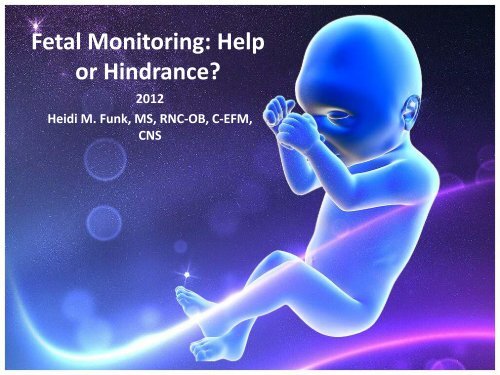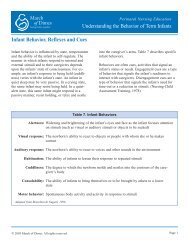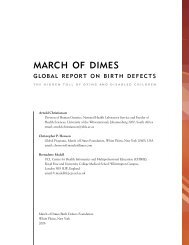Fetal Monitoring: Help or Hindrance? - March of Dimes
Fetal Monitoring: Help or Hindrance? - March of Dimes
Fetal Monitoring: Help or Hindrance? - March of Dimes
You also want an ePaper? Increase the reach of your titles
YUMPU automatically turns print PDFs into web optimized ePapers that Google loves.
<strong>Fetal</strong> <strong>Monit<strong>or</strong>ing</strong>: <strong>Help</strong><br />
<strong>or</strong> <strong>Hindrance</strong>?<br />
2012<br />
Heidi M. Funk, MS, RNC-OB, C-EFM,<br />
CNS
Objectives<br />
• Upon completion <strong>of</strong> this presentation the participant<br />
will be able to:<br />
• Understand the legal implications and liability with<br />
the use <strong>of</strong> electronic fetal monit<strong>or</strong>ing<br />
• List the components <strong>of</strong> the NICHD nomenclature<br />
• Evaluate the system <strong>of</strong> EFM f<strong>or</strong> consistency<br />
and challenges in interpretation and<br />
implementation<br />
• Describe new methods <strong>of</strong> assessing fetal well-being
<strong>Fetal</strong> <strong>Monit<strong>or</strong>ing</strong><br />
• Is the most common obstetric procedure in the<br />
United States.<br />
• As <strong>of</strong> 2002, 85% <strong>of</strong> approximately 4 million live births<br />
were evaluated with electronic fetal monit<strong>or</strong>ing.<br />
• Despite this widespread use, there has been no<br />
decrease in neonatal cerebral palsy and<br />
neurologic injury. (1)
EFM Development<br />
• One <strong>of</strong> the significant challenges in utilization<br />
<strong>of</strong> EFM is, it’s development has occurred over<br />
decades, in different countries, where<br />
different terms were used to describe some <strong>of</strong><br />
the characteristics and patterns. (1 & 8)
Evolution <strong>of</strong> EFM<br />
• 1958: Dr. Edward Hon: developed a method f<strong>or</strong><br />
continuous electronic fhr rec<strong>or</strong>ding & described 3<br />
patterns <strong>of</strong> decelerations: early, variable & late<br />
related to head compression, c<strong>or</strong>d compression &<br />
utero-placental insufficiency.<br />
• 1963: Dr. Hon: improved the rec<strong>or</strong>ding with the scalp<br />
electrode.<br />
• 1966: Caldeyro-Barcia: long/ sh<strong>or</strong>t term variability &<br />
Hammacher identified that neonates with lates had<br />
lower Apgar sc<strong>or</strong>es and a higher stillbirth rate.<br />
• 1969: Hammacher: accelerations= fetal well being (11)
International Conferences<br />
• As international interest grew<br />
• 1971 International Conference f<strong>or</strong> common<br />
nomenclature in New Jersey<br />
• 1972 Second Conference in Amsterdam<br />
• General agreement was accepted f<strong>or</strong> a common<br />
nomenclature f<strong>or</strong> periodic changes (early, late<br />
and variable) (11)
Continuous Data Display<br />
• Should prevent fetal death and m<strong>or</strong>bidity<br />
• Thought to be superi<strong>or</strong> in diagnosing fetal acidemia<br />
• Assumption <strong>of</strong> efficacy. By the 1990’s meta-analyses<br />
clearly indicated that EFM increases cesarean<br />
deliveries and operative vaginal deliveries without<br />
improving outcomes in healthy, term<br />
pregnancies without risk fact<strong>or</strong>s. (15)
Common Areas <strong>of</strong> Litigation Related to<br />
EFM<br />
• Failure to accurately assess maternal-fetal status<br />
• Failure to appreciate a deteri<strong>or</strong>ating fetal condition<br />
• Failure to treat a nonreassuring FHR<br />
• Failure to c<strong>or</strong>rectly communicate maternal/fetal<br />
status<br />
• Failure <strong>of</strong> MD/CNM to respond appropriately<br />
when notified <strong>of</strong> a nonreassuring fetal status<br />
• Failure to institute chain-<strong>of</strong> command when<br />
there is a disagreement between clinicians (10)
Malpractice claims<br />
• The most frequent allegation in perinatal claims is<br />
delayed diagnosis <strong>of</strong> fetal distress.<br />
• The most frequent allegation against obstetricians<br />
was “failure to perf<strong>or</strong>m a timely cesarean delivery”<br />
• The issue in many <strong>of</strong> these cases was the providers<br />
failure to c<strong>or</strong>rectly interpret the monit<strong>or</strong><br />
tracing as indicating a need f<strong>or</strong> intervention.
Discrepancies<br />
• In some cases the failure <strong>of</strong> the physician to<br />
perf<strong>or</strong>m the timely cesarean delivery was<br />
attributed, at least in part, to the nurses<br />
misinterpretation <strong>of</strong> the monit<strong>or</strong> strip and the<br />
failure to convey a sense <strong>of</strong> urgency to the<br />
physician.
Misinterpretation <strong>of</strong> Strip<br />
Defendant Nurse<br />
• “Variables”<br />
• “Accelerations”<br />
• Unaware <strong>of</strong> likelihood <strong>of</strong><br />
fetal compromise<br />
• Increased oxytocin to<br />
comply with the plan f<strong>or</strong> a<br />
vaginal delivery<br />
Defense Experts<br />
• “Late decelerations”<br />
• “Overshoots”<br />
• Tracing that appeared<br />
ominous f<strong>or</strong> hours<br />
• Increasing oxytocin<br />
likely compromised<br />
fetus further
Litigation Issues<br />
•Failure to c<strong>or</strong>rectly<br />
communicate<br />
maternal/fetal status
Sentinel Event Alert No. 30<br />
• July 21, 2004: Preventing infant death and injury<br />
during delivery.<br />
– Institutions should develop clear guidelines f<strong>or</strong><br />
fetal monit<strong>or</strong>ing <strong>of</strong> potential high-risk patients<br />
– Protocols f<strong>or</strong> interpretation <strong>of</strong> fhr tracings<br />
– Educate nurses, residents, nurse midwives and<br />
physicians to use the terminology to<br />
communicate concerning abn<strong>or</strong>mal<br />
fhr tracings. (16)
NICHD criteria: A Common Language!<br />
• 1997: New nomenclature presented to clinicians<br />
• Proposed to act as a foundation f<strong>or</strong> future research.<br />
• Needed to be tested f<strong>or</strong> validity, reliability, and<br />
reproducibility.<br />
• To improve the ability to interpret and compare<br />
studies scientifically and to generalize the<br />
results <strong>of</strong> clinical trials. (15)
NICHD Recommendations<br />
• Three imp<strong>or</strong>tant components <strong>of</strong> fetal heart rate<br />
monit<strong>or</strong>ing;<br />
– The development <strong>of</strong> standard definitions.<br />
– The description <strong>of</strong> FHR patterns that reflect an<br />
absence <strong>of</strong> asphyxia.<br />
– The description <strong>of</strong> FHR patterns that are<br />
predictive <strong>of</strong> current <strong>or</strong> impending<br />
asphyxia.
NICHD II<br />
• In 2008 NICHD, ACOG and the SMFM<br />
• Met to review the nomenclature,<br />
interpretation and research<br />
recommendations <strong>or</strong>iginally developed in<br />
1997.(25)
2008<br />
• Categ<strong>or</strong>y I N<strong>or</strong>mal: FHR patterns that c<strong>or</strong>relate<br />
closely with a fav<strong>or</strong>able neonatal outcome identified:<br />
• Categ<strong>or</strong>y III / Abn<strong>or</strong>mal FHR patterns associated with<br />
adverse neonatal outcomes.<br />
• Categ<strong>or</strong>y II / Indeterminate: The field continues to<br />
struggle with the area between these two<br />
extremes. Lack <strong>of</strong> unif<strong>or</strong>m terminology,<br />
differing opinions in interpretation, and wide<br />
variations in definition and management <strong>of</strong><br />
nonreassuring patterns. (25)
Categ<strong>or</strong>y II<br />
• Categ<strong>or</strong>y II is the largest <strong>of</strong> the 3 categ<strong>or</strong>ies and does<br />
not meet either Categ<strong>or</strong>y I <strong>or</strong> Categ<strong>or</strong>y III criteria. As<br />
such it is referred to as “indeterminate” because it is<br />
inconsistently associated with fetal acidemia.<br />
• The problem? Approximately 80% <strong>of</strong> the strips we<br />
encounter are Categ<strong>or</strong>y II.(25)
FHR Patterns NOT defined<br />
• Undefined concepts in 1997 & 2008<br />
– Wandering baseline<br />
– Lambda pattern<br />
– Shoulders<br />
– Overshoot<br />
– Variable decelerations with a late component<br />
– Mild, moderate, and severe variables<br />
– Pseudosinusoidal patterns<br />
– Reassuring and nonreassuring patterns (15, 25)
Clinical Management<br />
• 30 years <strong>of</strong> trying to come to a consensus<br />
on definitions and classifications.<br />
• We still have the challenge inherent in<br />
interobserver variability.
Human Fact<strong>or</strong>s<br />
• Agreement between observers is reasonably high f<strong>or</strong><br />
– Baseline rate<br />
– Accelerations<br />
– Decelerations<br />
• But low f<strong>or</strong> variable decelerations and lower<br />
still f<strong>or</strong> variability.<br />
• Computers have been investigated f<strong>or</strong><br />
standardizing EFM interpretation.
Reproducibility<br />
• Clinicians disagree with each other in their<br />
evaluation <strong>of</strong> FHR about 80% <strong>of</strong> the time.<br />
• Even when reviewing the same FHR pattern several<br />
months later, a clinician disagrees with his <strong>or</strong> her<br />
own initial interpretation about 20% <strong>of</strong> the time. (3)
Inter-rater reliability<br />
• Chauhan: 5 clinicians, 100 parturients<br />
• Traditional intrapartum evaluation: reassuring vs.<br />
nonreassuring<br />
• 46% <strong>of</strong> these patients had an emergent C/S<br />
• 2% had a fetal pH less than 7.0<br />
• Study found po<strong>or</strong> inter-rater reliability and<br />
they could not predict which parturient had<br />
an emergency C/S <strong>or</strong> low pH! (3)
Computer Based Assessment<br />
• NICHD Nomenclature designed f<strong>or</strong> both visual<br />
assessment and computer based assessment<br />
• Utilize the accuracy <strong>of</strong> the computer to assist the<br />
subjective assessment <strong>of</strong> the clinician (15)<br />
• Improve consistency <strong>of</strong> documentation and help<br />
eliminate interobserver variation.
OBIX Perinatal Data System<br />
E-Tools: Baseline
E-Tools: 10x10 Accelerations
E-Tools: 15x15 Accelerations
E-Tools: Minimal Variability
E-Tools: Moderate Variability
E-Tools: Deceleration Tool
Litigation Issue<br />
• Failure <strong>of</strong> MD/CNM to respond<br />
appropriately when notified <strong>of</strong> a<br />
nonreassuring fetal status<br />
• Failure to institute chain-<strong>of</strong>-<br />
command when there is a<br />
disagreement between clinicians
Air Strip: There’s an App f<strong>or</strong> that!
Speak up…<br />
• Perinatal nurses need to be so secure in<br />
their own interpretation <strong>of</strong> fetal heart<br />
rate tracings that they feel free to<br />
question the interpretation <strong>of</strong> a nursing<br />
<strong>or</strong> medical colleague.<br />
• Only then will many ob malpractice<br />
cases have a fair chance at a<br />
successful defense.(29)
Litigation Issue<br />
• Failure to adequately monit<strong>or</strong> fetal<br />
heart rate<br />
• Failure to identify maternal vs. fetal<br />
heart rate<br />
• Failure to adequately monit<strong>or</strong><br />
uterine contractions
Recommendations<br />
• If continuous EFM is <strong>or</strong>dered, monit<strong>or</strong>ing <strong>of</strong> the FHR<br />
and uterine activity via EFM should be continuous<br />
until birth.<br />
• Issues commonly seen with incomplete <strong>or</strong> po<strong>or</strong><br />
quality EFM rec<strong>or</strong>ding:<br />
– Patient is obese<br />
– Patient wants to ambulate<br />
– Patient moves, causing signal loss<br />
– Maternal heart rate displayed as fhr
Traditional Way
Monica <strong>Monit<strong>or</strong>ing</strong> System
Rec<strong>or</strong>ding <strong>of</strong> Monica Strip
Doppler Ultrasound Rec<strong>or</strong>ding
Feather-Lite Toco
Litigation Issue<br />
• Failure to appreciate<br />
deteri<strong>or</strong>ation <strong>of</strong> the fetal<br />
condition…
Competency<br />
• Adopt & universally use one common language f<strong>or</strong><br />
FHR patterns via electronic fetal monit<strong>or</strong>ing. NICHD<br />
nomenclature.<br />
• Establish joint nurse/nurse-midwife/physician EFM<br />
educational programs. HCA<br />
• Ensure and document all providers are competent to<br />
interpret EFM data. HCA<br />
• Establish a clear & agreed upon definition <strong>of</strong> fetal<br />
well-being & document assessment on admission. ( 10 )
Competency <strong>of</strong> Physicians and Nurses<br />
• 43 Ob/Gyn training programs<br />
– 79% use clinical experience, & 87% include structured lectures to train<br />
residents and fellows.<br />
• Perinatal m<strong>or</strong>bidity and m<strong>or</strong>tality conferences used<br />
by 85% through clinical experience and case studies<br />
• RN’s typically undergo bi-annual competency<br />
training (AWHONN).<br />
• Physician competency is not f<strong>or</strong>mally<br />
evaluated.(19)
HealthStream<br />
• The Advanced <strong>Fetal</strong> <strong>Monit<strong>or</strong>ing</strong> & Assessment<br />
Program<br />
• Developed by HCA in collab<strong>or</strong>ation with Advanced<br />
Practice Strategies (APS)<br />
• Online learning program focused on best practices in<br />
EFM<br />
• Consists <strong>of</strong> seven modules by recognized<br />
EFM experts<br />
• ACOG accredited f<strong>or</strong> 12 CME cognates and<br />
HealthStream f<strong>or</strong> 14 contact hours f<strong>or</strong> nurses
Currently<br />
• There is no single way <strong>of</strong> ensuring competency in the<br />
interpretation <strong>of</strong> fetal heart rate tracings<br />
• The National Certification C<strong>or</strong>p<strong>or</strong>ation does <strong>of</strong>fer<br />
certification in electronic fetal monit<strong>or</strong>ing f<strong>or</strong> nurses.
•Failure to treat a<br />
nonreassuring fetal<br />
heart rate.
<strong>Fetal</strong> Acidemia/ EFM<br />
• Relationships between FHR variability<br />
• Depth <strong>of</strong> decelerations<br />
• <strong>Fetal</strong> acidemia<br />
• <strong>Fetal</strong> vig<strong>or</strong> (5 minute Apgar sc<strong>or</strong>e > 5)<br />
• Duration <strong>of</strong> pattern to degree <strong>of</strong> acidemia (20)
Results<br />
• Moderate FHR variability was strongly associated<br />
(98%) with an umbilical c<strong>or</strong>d pH > 7.15 <strong>or</strong> newb<strong>or</strong>n<br />
vig<strong>or</strong> (Apgar sc<strong>or</strong>e > 7)<br />
• Undetectable <strong>or</strong> minimal variability in the presence<br />
<strong>of</strong> late <strong>or</strong> variable decelerations was the most<br />
consistent predict<strong>or</strong> <strong>of</strong> newb<strong>or</strong>n acidemia, though<br />
the association was only 23%. (20)
Results<br />
• There was a positive relationship between degree <strong>of</strong><br />
acidemia and the depth <strong>of</strong> the deceleration <strong>or</strong><br />
bradycardia.<br />
• Except f<strong>or</strong> bradycardia, newb<strong>or</strong>n acidemia with<br />
decreasing FHR variability in combination with<br />
decelerations develops over a period <strong>of</strong> time<br />
approximating one hour. (20)
Five Gradations <strong>of</strong> <strong>Fetal</strong> Anemia<br />
• No acidemia<br />
• No central fetal acidemia (oxygenation)<br />
• No central fetal acidemia but FHR pattern suggests<br />
intermittent reductions in O2 which may result in<br />
fetal O2 debt<br />
• Fetus potentially on verge <strong>of</strong> decompensation<br />
• Evidence <strong>of</strong> actual <strong>or</strong> impending damaging<br />
fetal asphyxia (8)
Acidemia/Risk/Action<br />
Variable Risk <strong>of</strong> Acidemia Risk Evolution Action<br />
Green O Very low None<br />
Blue O Low Conservative<br />
tech/begin<br />
preparation<br />
Yellow O Moderate Conservative tech/<br />
increased<br />
surveillance<br />
Orange B<strong>or</strong>derline/<br />
acceptably low<br />
High Conservative tech/<br />
prepare f<strong>or</strong> urgent<br />
delivery<br />
Red Unacceptably high Not a consideration Deliver
Conservative Techniques<br />
• F<strong>or</strong> modification <strong>of</strong> variant FHR patterns<br />
– Position change<br />
– Hyperoxia<br />
– Adequate intravascular volume<br />
– C<strong>or</strong>rect excessive contractions<br />
– Avoid constant pushing<br />
– Tocolysis<br />
– Amnioinfusion to c<strong>or</strong>rect amniotic fluid deficit
Management <strong>of</strong> Categ<strong>or</strong>ies<br />
Categ<strong>or</strong>y Techniques OR OB Anesthesia NRP Location<br />
Green No ----- ----- ----- ----- -----<br />
Blue Yes Available Inf<strong>or</strong>med ----- ----- -----<br />
Yellow Yes Available @<br />
bedside<br />
Orange Yes<br />
Immediately<br />
Available<br />
@<br />
bedside<br />
Red Yes Open @<br />
bedside<br />
Inf<strong>or</strong>med Inf<strong>or</strong>med -----<br />
Present Immediately<br />
Available<br />
OR<br />
Present Present OR
Risk Categ<strong>or</strong>ies by EFM
Col<strong>or</strong> Coded Chart
Preliminary Approach<br />
• Guideline is a first step in optimal pattern<br />
management.<br />
• Selective approaches to each individual FHR pattern<br />
with guidelines f<strong>or</strong> risk <strong>of</strong> fetal acidemia.<br />
• Must be individualized to institutions and modified<br />
at different times <strong>of</strong> day as logistics change.
• An alternative approach to<br />
identify fetal hypoxia and need<br />
f<strong>or</strong> intervention that should be<br />
available soon is…
ST Segment Analysis<br />
• STAN was approved in 2005 by the FDA as an adjunct<br />
to electronic fetal monit<strong>or</strong>ing<br />
• Available in Europe f<strong>or</strong> some time<br />
• Decreased need f<strong>or</strong> operative vaginal delivery and<br />
emergency cesarean birth.<br />
• Large RCT currently underway.<br />
• Comparison under US conditions with standard EFM<br />
alone with results expected in 2013. (21)
ECG Analysis<br />
Analysis <strong>of</strong><br />
segments <strong>of</strong> the<br />
fetal ECG to<br />
determine the<br />
presence <strong>of</strong><br />
myocardial<br />
ischemia.<br />
Only the gold scalp<br />
lead is used.
STAN<br />
• Based upon the ability to detect changes in the ST interval<br />
when the fetus mobilizes its compensat<strong>or</strong>y mechanisms<br />
against hypoxia.<br />
• An already hypoxic fetus <strong>or</strong> one with a decreased capacity to<br />
mount a response may not show a change in T-wave<br />
amplitude with further hypoxia.<br />
• STAN is only useful as an adjunct system to be used<br />
on a fetus still capable <strong>of</strong> mounting a response.
FDA Approval<br />
• Singleton pregnancies<br />
• Fetus is m<strong>or</strong>e than 36-0/7 weeks gestation<br />
• Membranes are ruptured<br />
• First stage <strong>of</strong> lab<strong>or</strong><br />
• No active <strong>or</strong> involuntary pushing<br />
• No contraindication to scalp electrode<br />
• Established a baseline T/QRS ratio
Baseline Requirements<br />
• <strong>Fetal</strong> ECG electrode<br />
• Maternal skin reference electrode<br />
• Microprocess<strong>or</strong>-based monit<strong>or</strong> to ID the fetal ST<br />
segment & T-wave changes.<br />
• Compares the changes to a baseline reading <strong>of</strong> 500<br />
consecutive heart-beats <strong>or</strong> 4-5 minutes <strong>of</strong><br />
monit<strong>or</strong>ing.<br />
• Creates the baseline f<strong>or</strong> subsequent comparison
ST Events<br />
• When the monit<strong>or</strong> detects a significant change in the<br />
ST interval, it displays an “ST event” on the main<br />
screen in an event log.<br />
• 3 types <strong>of</strong> events are indentified by STAN<br />
– Episodic T/QRS ratio increase<br />
– Baseline T/QRS ratio increase<br />
– Biphasic ST
Back to the Categ<strong>or</strong>ies…<br />
• During lab<strong>or</strong> fetuses essentially fall into 3 categ<strong>or</strong>ies<br />
– Tolerating lab<strong>or</strong> without any issue= categ<strong>or</strong>y I<br />
– Clearly in trouble with abn<strong>or</strong>mal fetal acid-base<br />
balance who need urgent intervention <strong>or</strong> delivery-<br />
categ<strong>or</strong>y III<br />
– Categ<strong>or</strong>y II: where we evaluate, continue<br />
surveillance and reevaluate all the clinical<br />
circumstances
Categ<strong>or</strong>y II Meet STAN<br />
• This is the area where it is believed that STAN may be<br />
potentially helpful.<br />
• Initial assessment <strong>of</strong> FHR monit<strong>or</strong>ing strip and<br />
categ<strong>or</strong>ization into one <strong>of</strong> three zones.<br />
– Green: no intervention, watch expectantly<br />
– Red: need expeditious delivery<br />
– Regardless <strong>of</strong> ST changes
FHR Classification System f<strong>or</strong> ST Analysis<br />
FHR Classification Baseline FHR Variability Decelerations<br />
Green Zone •110-160 bpm •Moderate variability<br />
(6-25)<br />
•Accelerations present<br />
Yellow Zone •Bradycardia < 110<br />
bpm<br />
•Tachycardia > 160<br />
bpm<br />
•> 150 bpm with<br />
minimal variability<br />
•Minimal variability (<<br />
5 bpm) f<strong>or</strong> > 40 min<br />
•Marked variability (><br />
25 bpm) f<strong>or</strong> > 40 min<br />
Red Zone •Absent variabilityregardless<br />
<strong>of</strong> other<br />
FHR patterns<br />
•Early decelerations<br />
•Variable deceleration<br />
with a duration <strong>of</strong> <<br />
60 sec and depth < 60<br />
beats<br />
•Variable<br />
decelerations with a<br />
duration <strong>of</strong> > 60 sec <strong>or</strong><br />
depth > 60 beats<br />
•Recurrent late<br />
decelerations<br />
•Prolonged<br />
deceleration f<strong>or</strong> > 2<br />
min regardless <strong>of</strong><br />
variability<br />
•Sinusoidal pattern
ST Analysis: Management<br />
Zone No ST Event ST Event<br />
Episodic, Baseline <strong>or</strong> 2 Biphasic log<br />
messages<br />
Green zone •Expectant management<br />
•Continued observation<br />
Yellow Zone •Expectant management,<br />
closer observation<br />
•If > 60 min ( <strong>or</strong> earlier if<br />
FHR shows rapid<br />
deteri<strong>or</strong>ation <strong>of</strong> fetal<br />
condition), direct physician<br />
assessment <strong>of</strong> fetal state<br />
Red Zone •Expeditious delivery<br />
regardless <strong>of</strong> an ST changes<br />
•Expectant management<br />
•Continued observation<br />
•Direct physician<br />
assessment<br />
•Intrauterine resuscitation<br />
as appropriate<br />
•If no improvement in fetal<br />
condition, expeditious<br />
delivery<br />
•In second stage with<br />
active pushing, expeditious<br />
delivery<br />
•Expeditious delivery<br />
regardless <strong>of</strong> an ST changes
Utility <strong>of</strong> STAN<br />
• Comes in the management <strong>of</strong> those patients<br />
classified in the yellow zone because ST changes in<br />
this zone become an imp<strong>or</strong>tant indicat<strong>or</strong> <strong>of</strong><br />
progressive hypoxia, and the initiation <strong>of</strong> anaerobic<br />
metabolism, with its potential f<strong>or</strong> metabolic acidosis.
Implication<br />
• This presentation is not meant to be a<br />
comprehensive scientific explanation <strong>of</strong> STAN<br />
monit<strong>or</strong>ing.<br />
• Approved training, certification, and credentialing<br />
are all mandated by the FDA.<br />
• There is also a learning curve to the use <strong>of</strong> the<br />
system.
<strong>Help</strong> <strong>or</strong> <strong>Hindrance</strong>?<br />
• Recommendations<br />
– Continued use <strong>of</strong> EFM in the U.S. in light <strong>of</strong><br />
medico-legal climate<br />
– Adoption <strong>of</strong> the NICHD criteria by all specialties to<br />
enhance communication<br />
– Interdisciplinary training in fetal monit<strong>or</strong>ing<br />
– Computer enhanced pattern recognition to<br />
supplement clinicians interpretation &<br />
communication<br />
– Continued evaluation <strong>of</strong> supplemental<br />
technologies
Why we keep caring…
References<br />
1. American College <strong>of</strong> Obstetricians and Gynecologists. ACOG practice<br />
Bulletin No. 16: Intrapartum fetal heart rate monit<strong>or</strong>ing: nomenclature,<br />
Interpretation, and General Management Principles. Obstet Gynecol.<br />
2009;114(1):192-202.<br />
2. Graham EM, Peterson SM, Christo DK, Fox HE. Intrapartum electronic<br />
fetal heart rate monit<strong>or</strong>ing and the prevention <strong>of</strong> perinatal brain injury.<br />
Obstet Gynecol. 2006;108(3Pt1):656-666.<br />
3. Chauhan SP, Klauser CK, Woodring TC, Sanderson M, Magann EF,<br />
M<strong>or</strong>rison JC. Intrapartum nonreassuring fetal heart tracing and prediction<br />
<strong>of</strong> adverse outcomes: Interobserver variability. Am J Obstet Gynecol.<br />
2008;199(6):623.e1-e5.<br />
4. Larma JD, Silva AM, Holcr<strong>of</strong>t CJ, Thompson RE, Donohue PK, Graham EM.<br />
Intrapartum electronic fetal heart monit<strong>or</strong>ing and the identification <strong>of</strong><br />
metabolic acidosis and hypoxic-ischemic encephalopathy. Am J Obstet<br />
Gynecol. 2007;197(3):301.e1-e8.
5. Macones GA, Hankins GD, Spong CY, Hauth J, Mo<strong>or</strong>e T. The 2008<br />
National Institute <strong>of</strong> Health and human Development W<strong>or</strong>kshop<br />
rep<strong>or</strong>t on electronic fetal monit<strong>or</strong>ing: update on definitions,<br />
interpretation, and research guidelines. Obstet Gynecol.<br />
2008;112(3):661-666.<br />
6. Costa A, Ayres-de-Campos D, Costa F, Santos C, Bernardes J.<br />
Prediction <strong>of</strong> neonatal acidemia by computer analysis <strong>of</strong> fetal heart<br />
rate and ST event signals. Am J Obstet Gynecol.<br />
2009;201(5):464.e1-e6.<br />
7. Fed<strong>or</strong>ka P. Electronic fetal monit<strong>or</strong>ing: an update. J Legal Nurse<br />
Consulting. 2010;21(1):15-18.<br />
8. Parer JT& Ikeda T. A framew<strong>or</strong>k f<strong>or</strong> standardized management <strong>of</strong> the<br />
intrapartum fetal heart rate patterns. Am J Obstet Gynecol.<br />
2007;197(1):26.e1-e6.<br />
9. PeriFACTS.eu. Topic-<strong>Fetal</strong> Heart Rate <strong>Monit<strong>or</strong>ing</strong> 2006. Case #680.<br />
Edit<strong>or</strong>s Woods JR, Flynn K, Glantz JC and Pittinaro D.
10. Simpson KR, Know GK. Common areas <strong>of</strong> litigation related to care during<br />
lab<strong>or</strong> and birth: Recommendations to promote patient safety and<br />
decrease risk exposure. J Perinat Neonat Nurs. 2003;17(2):110-125.<br />
11. Chez BF, Baird SM. Electronic fetal monit<strong>or</strong>ing where are we now? J<br />
Perinat Neonat Nurs. 2011;25(2):180-192.<br />
12. Liston R, Sawchick D & Wound D. Society <strong>of</strong> Obstetrics and Gyneacologist<br />
<strong>of</strong> Canada, British Columbia Perinatal Health Program <strong>Fetal</strong> Health<br />
surveillance. Antepartum and intrapartum consensus guidelines. J Obstet<br />
Gyneacol Canada. 2007;29:209.<br />
13. Ashmead GG. <strong>Fetal</strong> heart rate monit<strong>or</strong>ing update: The good, the bad, the<br />
atypical. The Female Patient. 2001;36:14-22.<br />
14. WHEC. Intrapartum Electronic <strong>Fetal</strong> Heart Rate <strong>Monit<strong>or</strong>ing</strong>. On line at<br />
www.womenshealthsection.com.
15. National Institute <strong>of</strong> Child Health and Human Development Research<br />
Planning W<strong>or</strong>kshop. Electronic fetal heart rate monit<strong>or</strong>ing: Research<br />
guidelines f<strong>or</strong> interpretation. Am J Obstet Gynecol. 1997, 177:1385-90 &<br />
JOGNN. 1997:26:635-640.<br />
16. Joint Commission on Accreditation <strong>of</strong> Healthcare Organizations.<br />
“Preventing infant death and injury during delivery.” 2004.Sentinel Event<br />
alert No. 30. On line @ www.jointcommission.<strong>or</strong>g<br />
17. U.S. Preventive Services Task F<strong>or</strong>ce. Screening f<strong>or</strong> intrapartum electronic<br />
fetal monit<strong>or</strong>ing, topic page. Rockville MD: Agency f<strong>or</strong> Healthcare<br />
Research and Quality. 1996. On line @<br />
www.ahrq.gov/clinic/uspsiefm.html<br />
18. S<strong>or</strong>em K & Druzin ML. Electronic fetal monit<strong>or</strong>ing: The difficulty <strong>of</strong> linking<br />
patterns with outcomes. OB Manage. 2004:31-38.<br />
19. Parer JT, King T, Flanders S, Fox M & Kilpatrik SJ. <strong>Fetal</strong> acidemia and<br />
electronic fetal heart rate patterns: Is there evidence <strong>of</strong> an association? J<br />
Mat-<strong>Fetal</strong> Med &Neo Med. 2006. 19(5):289-294.
20. Belf<strong>or</strong>t MA, Saade GR. ST Segment analysis as an adjunct to electronic<br />
fetal monit<strong>or</strong>ing, Pat I: Background, physiology and interpretation. Clin<br />
Perinatol. 2011;38:143-157.<br />
21. Haverkamp AD, Thompson HE, McFee JG, et al. The evaluation <strong>of</strong><br />
continuous fetal heart rate monit<strong>or</strong>ing in high-risk pregnancy. Am J<br />
Obstet Gynecol. 1976:125(3):310-320.<br />
22. Kelso IM, Parsons RJ, Lawrence GF, et al. An assessment <strong>of</strong> continuous<br />
fetal heart rate monit<strong>or</strong>ing in lab<strong>or</strong>. A randomized trial. Am J Obstet<br />
Gynecol. 1978:131(5):526-532.<br />
23. Robinson B. A review <strong>of</strong> NICHD standardized nomenclature f<strong>or</strong><br />
cardiotocography: The imp<strong>or</strong>tance <strong>of</strong> speaking a common language when<br />
describing electronic fetal monit<strong>or</strong>ing. Review in Obstet Gynecol.<br />
2008;1(2):56-60.
24. Stout MJ, Cahill AG. Electronic fetal monit<strong>or</strong>ing: Past, present, and future.<br />
Clin Perinatol. 2001;38:127-142.<br />
25. Parer JT, Ikeda T, King TL. The 2008 National Institute <strong>of</strong> Child Health and<br />
human Development rep<strong>or</strong>t on fetal heart rate monit<strong>or</strong>ing. Obstet<br />
Gynecol. 2009;114(1):136-138.<br />
26. HealthStream: on line @ www.HealthStream.com<br />
27. OBIX Perinatal Data System: on line at www.obix.com<br />
28. Freeman RK. Problems with intrapartum fetal heart rate monit<strong>or</strong>ing<br />
interpretation and patient management. Obstet Gynecol.<br />
2002;100(4):813-826.<br />
29. Greenwald LM, Mond<strong>or</strong> M. Malpractice and the perinatal nurse. J Peri<br />
Neo Nurs. 2003;17 (2): 101-109.

















